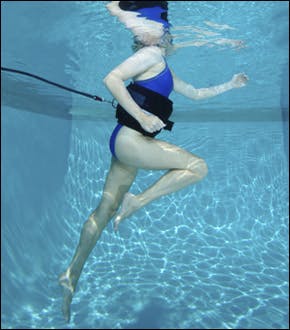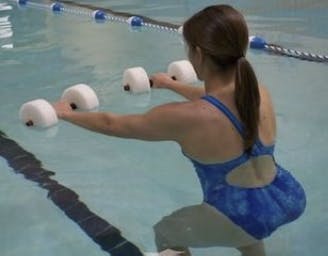At Sacramento Spine & Physical Therapy, we have the most advanced and established aquatic therapy program in the region. For patients who are in pain and are weakened due to an injury or disability, aquatic therapy offers the perfect solution. The natural buoyancy of water reduces the stress on the body and helps patients exercise easier with less pain. Plus, the natural pressure of water reduces joint and soft-tissue swelling and provides enough resistance to strengthen muscle.
Aquatic therapy is available seasonally at our Folsom location.

What is "aquatic physical therapy"?
Aquatic Physical Therapy is the evidence-based and skilled practice of physical therapy in an aquatic environment. Aquatic Physical Therapy includes but is not limited to treatment, rehabilitation, prevention, health, wellness and fitness of patient/client populations in an aquatic environment. The unique properties of the aquatic environment enhance interventions for patients/clients across the age span with musculoskeletal, neuromuscular, cardiovascular/pulmonary, and more disorders, or conditions.What is it good for?
Aquatic Physical Therapy interventions are designed to improve or maintain:- Function
- Aerobic capacity/endurance conditioning
- Balance, coordination and agility
- Body mechanics and postural stabilization
- Flexibility
- Gait and locomotion
- Relaxation
- Muscle strength, power, and endurance
- Difficulty walking or limited weight-bearing capacity
- Fibromyalgia
- Extremity injuries, which prevent regular conditioning on normal surfaces or in athletic participation
- Spinal dysfunction, which prevents exercise on normal surfaces due to pain, immobility and/or compression
- Arthritis
- Pregnancy-related musculoskeletal pain
- Total hip/knee joint replacements
- Unsuccessful attempts at land-based therapy


How does it work?
Aquatic Physical Therapists are licensed physical therapists that perform an examination and evaluation to establish a functional diagnosis, prognosis for functional recovery, and need for PT treatment with a plan of care. Aquatic PT's and PT Assistants provide treatments in a safe aquatic environment taking into consideration transition to land based functional activities and communication with the patient-care team. What is the difference between "aquatic physical therapy" and "aquatic exercise"? The difference is that aquatic physical therapy requires the "skilled service" of a PT and/or PTA, which may include:- The clinical reasoning and decision-making skills of a PT/PTA;
- There are impairments and/or disabilities, which can be minimized or eliminated with aquatic physical therapy; and the patient has potential to maximize functional goals/outcomes to improve quality of life and ease burden of care; and
- The implementation of such therapy must comply with all standards of care, which impact all other treatment services.
- 82-88 degrees for more active patients and patients with MS
- 88-92 degrees for less active patients such as those with arthritis
- 92-96 degrees for less active patients with hypertonicity/spasticity issues
Please download and have your healthcare provider complete:
Aquatic Therapy Referral Form